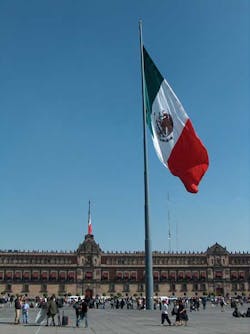Megacity Mexico: A Tale of Leaks and Shortages
With Mexico City wasting as much water as some cities consume, leakage is a huge problem across the sprawling urban metropolis. Why is the megacity suffering more than others? What privatisation measures have been successful elsewhere that can be implemented? Jeremy Josephs investigates.
Mexico City often makes the news because of its notorious air pollution. Yet in fact it is water that is the source of more problems – and one that might not necessarily be easy to spot. If there's one place in the world where residents cannot afford to be wasting water then it's surely Mexico City. Why? Because its population has exploded from 1.75 million souls back in 1940 to over 21 million people today, thus conferring upon it the dubious honour of being the fifth largest metropolitan area in the world, a megacity if ever there was one.
We are living, as a recent WWF report noted, in “an urbanising world". Not that leaks are the city's only worries when it comes to water issues - over-exploitation of aquifers has had a significant part to play in subsidence which continues to increase the risk of catastrophic flooding. Plus Mexico's City's dependence on distant water supplies has led, unsurprisingly, to stresses and strains with donor basin communities.
Expensive transfer
The Cutzamala transfer system is one of the largest in the world due to the quantity (some 485 million m3/year) and altitude that the water traverses to reach the sprawling Mexican metropolis. And it will equally come as no surprise to know that ensuring an uninterrupted water supply to the capital does not come cheaply – high energy costs are directly linked to pumping water to over 1000 meters in elevation and from over 150 kilometers away. All of which combines to suggest that in a city where water is both costly and in short supply pouring some 40% of this precious resource down the plughole, so to speak, is surely something close to both water science and environmental insanity.
Mexico City actually wastes as much water as some of the world's largest cities use. The massive leaks are, in turn, an integral part of a vicious cycle when it comes to drinking water quality. For when the soil is permeated by sewage from leaking sewers, then it is clear that leaky pipelines will become infiltrated with contaminated water, especially when pressure is low.
The Federal District's water quality laboratory has also confirmed that those neighbourhoods that experience more frequent interruptions in service do indeed have poorer quality when compared to areas which enjoy a constant supply. Hardly surprising, then, the prevailing atmosphere in the city is one of a general distrust of tap water quality. This has led to much of the population purchasing drinking water. Mexico is now ranked as the third largest consumer of bottled water in the world. Sinking citY
The pressures on the city's water system have now become so acute that its burgeoning population continues to extract water from its aquifers as a rate that is more than twice as fast as they are replenished. The results are there for all to see - the city is sinking on top of the aquifer that supplies it, having fallen nearly 10 meters during the course of the last century and continuing to drop by as much half a meter per year in some areas. Needless to say this is not good for the city's already broken down network of leaking pipes where nearly 11 cubic meters of water are lost per second.
The city has over 1000 km of main pipes and a secondary network of more than 12,000 km. When it comes to the issue of leaks, however, the core issue is not at all difficult to diagnose and detect.
Engineer Antonio Gutierrez Marcos, director of Water Supply, Sewerage and Sanitation at the Water Agency Cuenca del Valle de Mexico, says: “The basic problem is the age of the network – the networks are very old and obsolete. On top of this you have the problem of differential subsidence in the Valley of Mexico, which frequently creates breaks. The problem is compounded by the fact there is a lack of resources when it comes to successfully managing the utility – you might even say an atmosphere of lack and attention and neglect. Nor are leaks the beginning and end of the story – we estimate that there is a further 20% loss when it comes to bill errors and clandestine connections. This in turn means that the city struggles to give momentum to its projects to replace the old pipes."
A chemist by training, Manuel Guerra heads up the Independent Institute for Environmental Research in Mexico City and agrees: “The main problem is that due to the subsidence of the ground - the sinking of the city - the pipes break. Pipes with sewage water and pipes with drinking water, so there's a mixing of both. And then you can and do have enormous health problems accompanying that - diarrhoea, a major issue with cholera - and so on.
“Of course you can't blame the city's inhabitants for preferring to drink bottled water – but not everyone can afford it. It's quite another story across town, you know, where behind the walls of upper-class suburbs you can see sprinklers drenching the grass with drinking water. You see what I'm saying? You know two million people in Mexico City have no running water. In other words, water leaks and shortages are not felt equally."
Water leakage project
This is not to suggest, however, that the powers that be are unaware of the financial and social costs generated by massive leaks. Back in 2000 the Mexico City Council (via the Mexico City Water System) initiated a major sectoring project in respect of the drinking water network. The aim was improving its poor track record in respect of water leakage control and reducing water losses in the water supply system.
The purpose of the project was to create sectors and sub-sectors within the network by the installation of segmentation valves at one or two inlet points for each sector. The hope was that this would enable the identification and control of losses in each sector.
Prior to the sectoring project the drinking water network was divided into just five large zones. But for the purposes of the sectoring project the network was divided into sectors based mainly on geographical/topographical features and water consumption. The established size of the sectors was approximately 5,000 connections or 25,000 inhabitants. Sector boundaries were defined by naturally occurring borders (rivers, ravines, parks and so on), then railway lines, roads and political boundaries too. The various inlet points of each sector were identified with a view to measuring flows more easily. Hydraulic control pressure valves were included and installed within various sectors.
In the event Mexico City's drinking water network was divided in 336 sectors. Local officials were rather pleased with the results - pressure control thanks to the installation of pressure reducing valves enabled a decrease in water losses from 35% to 23% of flow rate supplied.
It demonstrated that a well defined sector can provide data and useful information to quickly identify invisible leaks and establish priority sectors for leak detection. While not tackling the city's underlying problems (literally so in this instance) the network's sectorization project was nevertheless a preliminary but successful stage in leak detection.
Privatisation as the answer?
Mexico City's water supply system has already had a taste of the private sector alike – from 1994 to 2011, to be precise. Initially the Distrito Federal (city council) administration successfully employed private actors to provide more extensive and efficient services while retaining public control of infrastructure. Privatization in the Distrito Federal was unique in its competitive service structure and the support provided to it by the city's populist government.
The reality was that on the ground political manoeuvring stalled progress in contract governance, network extension and regional coordination, all of which combined to suggest the need for more robust accountability structures linking municipal and national political outcomes to household service delivery.
Environmentalists like Guerra are in fact the unlikely advocates for more rather than less privatization.
“Because the people who pay the highest price for water in Mexico City are the poor. Since they have to buy water from water tanks and water cars that charge ten times as much as City Hall for water. That's why I would privatize the water distribution system to make companies responsible for bringing good quality water into their homes. Install modern metering systems to double or triple the amount of money collected."
The Israeli water-tech firm TaKaDu is situated just outside of Tel Aviv. That's some 12,500 kilometers from Mexico City. But that hasn't prevented its CEO, Amir Peleg (who also chairs SWAN – the Smart Water Networks Forum) from proffering what might be some very good advice.
“Smart water network technologies or, in other words, the use of data-driven technologies can have a role to play in helping improve the performance of water utilities and reduce losses," he says. “By using network data in a smart way, water utilities can increase their visibility and have control over their network…I am not saying that this is going to be the magic formula for Mexico City – clearly there are more complex factors at play. But I would be bet my bottom shekel that it would help reduce their massive leakages right away."
We have seen, then, that the massive leaks experienced in Mexico City, and the jaw-dropping quantities of water lost consequentially, are but the symptoms of far more complex problems. And that unless and until a sustainable solution is found to the mega-city's problems – notably in terms of subsidence – even successful short-term, stop-gap measures such as sectoring can and will have only a very limited positive impact. A wholesale review of the city's approach to water management is required – and fast.
It is surely not without some irony that a couple of years ago there was an amendment to Mexico's constitution which made access to potable water a basic human right. Fine words which will almost certainly mean very little to those languishing in Mexico City's huge slum of Ixtapalapa. And here's another rather fine illusion. In the more affluent city centre, which remains popular with tourists, the four giant pillars of the Monument of the Revolution rise over thirty meters above the ground. In front a fountain bubbles away peacefully.
The suggestion is that all well with water in Mexico City. But it is not. Many commentators are now wondering precisely how long it will be before the less affluent citizens of Mexico City will speak their mind. It might well be time, one suspects, to plug those leaks.
Author's note: Jeremy Josephs is a freelance contributor to WWi magazine. For more information, contact: [email protected]



